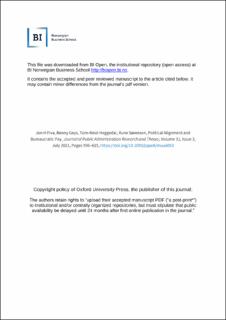| dc.contributor.author | Fiva, Jon H. | |
| dc.contributor.author | Geys, Benny | |
| dc.contributor.author | Heggedal, Tom-Reiel | |
| dc.contributor.author | Sørensen, Rune Jørgen | |
| dc.date.accessioned | 2022-02-02T16:54:20Z | |
| dc.date.available | 2022-02-02T16:54:20Z | |
| dc.date.created | 2020-12-01T15:50:47Z | |
| dc.date.issued | 2020 | |
| dc.identifier.citation | Journal of Public Administration Research and Theory, 2021, Volume 31, Issue 3, Pages 596–615 | en_US |
| dc.identifier.issn | 1053-1858 | |
| dc.identifier.uri | https://hdl.handle.net/11250/2976739 | |
| dc.description.abstract | Building on agency-theoretical perspectives of public bureaucracies, we argue that politician–bureaucrat preference alignment can have important implications for bureaucrats’ pay. We study such private gains to bureaucrats from their political alignment with elected politicians using detailed data on all 1,632 top administrators active in all Norwegian municipalities over a period of 25 years (1991–2015). Whereas existing studies generally rely on proxies for politician–bureaucrat political alignment, a rare feature of our data allows measuring it directly since 27% of top bureaucrats ran for political office. We focus explicitly on individuals at the very top of the administrative hierarchy and are able to separate the intensive margin (i.e., wage increases) from any additional effects at the extensive margin (i.e., new appointments). Using close elections for inference in a regression discontinuity analysis, we find that politician–bureaucrat alignment significantly increases top bureaucrats’ wage even in the Norwegian civil service system. This has important implications also from a theoretical perspective. Our results indeed go against predictions from models with policy-motivated bureaucrats, but are consistent with politically aligned principal–agent matches being more productive | en_US |
| dc.language.iso | eng | en_US |
| dc.publisher | Oxford Uni. Press | en_US |
| dc.title | Political Alignment and Bureaucratic Pay | en_US |
| dc.type | Journal article | en_US |
| dc.type | Peer reviewed | en_US |
| dc.description.version | acceptedVersion | en_US |
| dc.rights.holder | Oxford University Press | en_US |
| dc.source.pagenumber | 596-615 | en_US |
| dc.source.volume | 31 | en_US |
| dc.source.journal | Journal of public administration research and theory | en_US |
| dc.source.issue | 3 | en_US |
| dc.identifier.doi | 10.1093/jopart/muaa053 | |
| dc.identifier.cristin | 1854953 | |
| cristin.ispublished | false | |
| cristin.fulltext | postprint | |
| cristin.qualitycode | 2 | |
